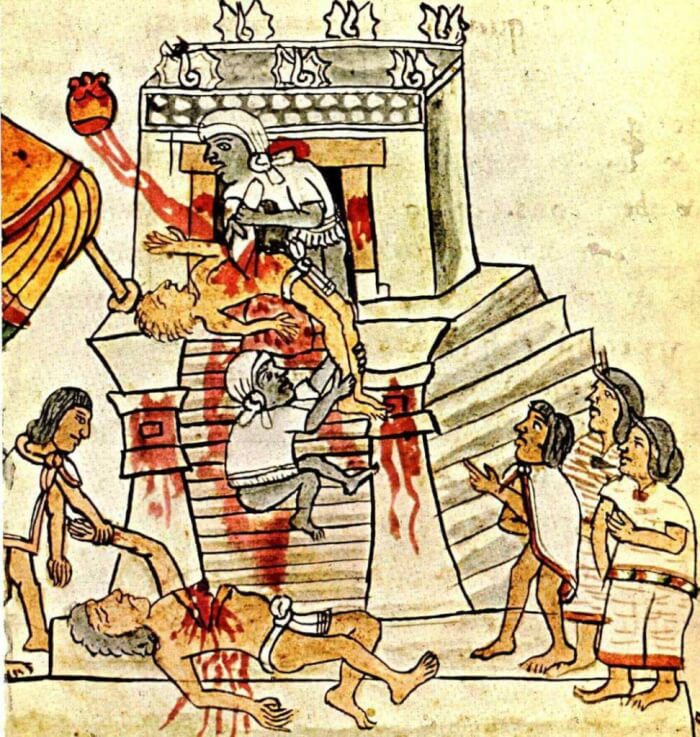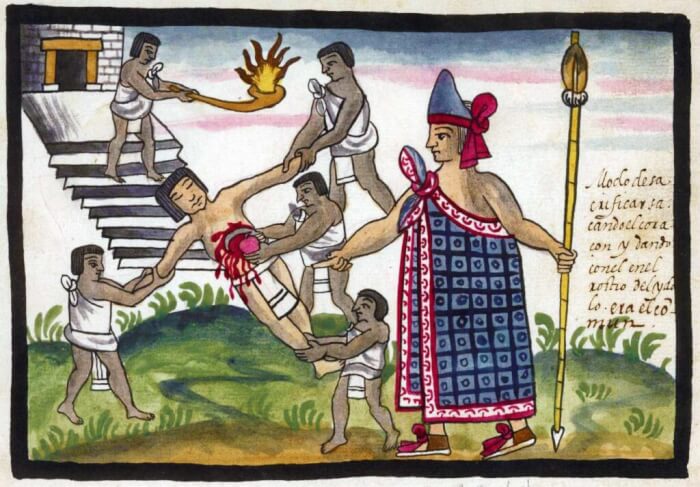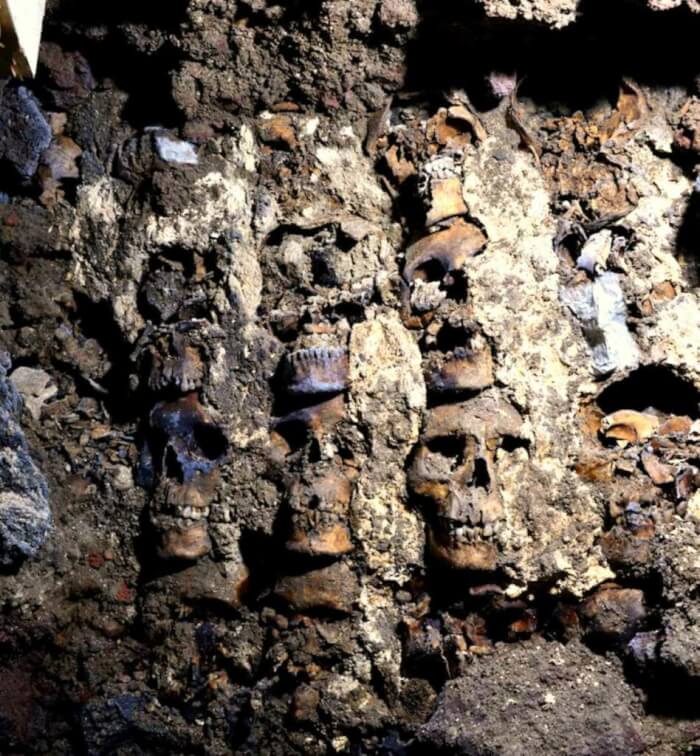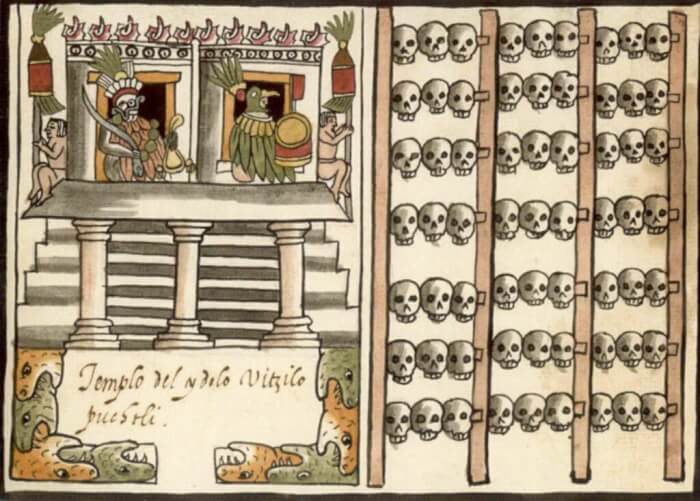Human Sacrifice In Aztec Civilization Created Massive Towers Of Skulls
Among the most important practices of the Mexica people, religion and rites, the practice of human sacrifice is the most prominent, being the greatest offering dedicated to divine beings.
Both the chronicles were written in Nahuatl and Spanish. The iconography contained in the pictographic manuscripts depicts specifically the different types of human sacrifice practiced in Mexico-Tenochtitlan, the insular capital of the Mexica.
In 2011, chronicler Tim Stanley wrote: “A culture obsessed with death: They believed that human sacrifice was the highest form of karmic healing. When the Great Pyramid of Tenochtitlan was consecrated in 1487, the Aztecs recorded that 84,000 people were slaughtered in four days.”
Stanley continued, “Self-sacrifice was common, and individuals would pierce their ears, tongues, and genitals to nourish the floors of temples with their blood. Unsurprisingly, there is evidence that Mexico was already suffering from a demographic crisis before the Spanish arrived.”
That number is disputed, however. Some say as few as 4,000 were sacrificed during the re-consecration of the Templo Mayor in 1487.
Primarily conducted during festivals on a calendar of 18 months, each of which consisted of 20 days, human sacrifices corresponded to a particular divinity. The ritual had as its function the introduction of man into the sacred.
It acted as a means of introducing the person into a different world, such as the one corresponding to heaven or the underworld, and for this, it was essential to have an enclosure and have a ritual.
Several features of the enclosures employed, ranging from a natural setting on a mountain or hill, a forest, a river, a lagoon, or a cenote, are presented. They were enclosures created for this purpose as temples and pyramids.
In the case of the Mexica or Aztecs already located in the city of Tenochtitlan, they had a Greater Temple, the Macuilcall I or Macuilquiahuitl, where the spies of enemy cities were sacrificed, and their heads were skewered on a wooden stake.
Archaeologists discovered 119 human skulls, adding up to the 484 already found before, in this section of the monument, an altar where the still bloody heads of sacrificed captives were impaled in public view to honor the gods.
Proof of sacrifices of women and 3 children was discovered among the ruins found from the Aztec Empire, as the bones were embedded onto the structure. Covered in lime, the skulls formed part of the construction near the Templo Mayor, one of the important worshipping location in Tenochtitlán.
The site is thought to be part of a temple dedicated to the Aztec god of the sun, war and human sacrifice, housing remains possibly from children, men and women murdered during these sacrificial ceremonies.
Archaeologists believe that this site was part of a temple dedicated to the Aztec god of the sun, war, and human sacrifice. They also detailed that the remains probably belonged to children, men and women killed during these sacrificial rituals.
This aspect is usually seen in numerous Mesoamerican civilizations before the Spanish Conquest. 3 phases of the establishment of the tower, dating to between 1486 and 1502 were discovered. But this dig in the bowels of the ancient Mexico City, starting in 2015, proposes that the image held until now was not of everything complete.
The skulls would have been placed in the tower after having been publicly displayed in the tzompantli. Measuring approximately five meters in diameter, the building stood at the corner of the chapel of Huitzilopochtli, the Aztec god of the sun, war, and human sacrifice who was the patron of the Aztec capital.
Undoubtedly, this structure was part of one of the skull buildings mentioned by Andrés de Tapia, a Spanish soldier who accompanied Cortés. Tapia detailed that there were tens of thousands of skulls in what became known as Huey Tzompantli. Specialists have already found 676 and are clear that this number will increase as the excavations progress.
 Source: Pinterest
Source: Pinterest
Both the chronicles were written in Nahuatl and Spanish. The iconography contained in the pictographic manuscripts depicts specifically the different types of human sacrifice practiced in Mexico-Tenochtitlan, the insular capital of the Mexica.
Human sacrifice of Mexicas
The most common type of offering in Aztec civilization was the extraction of the victim’s heart. Spanish conquistador Hernán Cortés and his men wrote that they observed a gruesome ritual upon their arrival in Tenochtitlan, the capital of Aztec, in 1521. Source: Pinterest
Source: Pinterest
In 2011, chronicler Tim Stanley wrote: “A culture obsessed with death: They believed that human sacrifice was the highest form of karmic healing. When the Great Pyramid of Tenochtitlan was consecrated in 1487, the Aztecs recorded that 84,000 people were slaughtered in four days.”
Stanley continued, “Self-sacrifice was common, and individuals would pierce their ears, tongues, and genitals to nourish the floors of temples with their blood. Unsurprisingly, there is evidence that Mexico was already suffering from a demographic crisis before the Spanish arrived.”
That number is disputed, however. Some say as few as 4,000 were sacrificed during the re-consecration of the Templo Mayor in 1487.
Three kinds of bloody rituals
 Source: Flickr
Source: Flickr
Primarily conducted during festivals on a calendar of 18 months, each of which consisted of 20 days, human sacrifices corresponded to a particular divinity. The ritual had as its function the introduction of man into the sacred.
It acted as a means of introducing the person into a different world, such as the one corresponding to heaven or the underworld, and for this, it was essential to have an enclosure and have a ritual.
Several features of the enclosures employed, ranging from a natural setting on a mountain or hill, a forest, a river, a lagoon, or a cenote, are presented. They were enclosures created for this purpose as temples and pyramids.
In the case of the Mexica or Aztecs already located in the city of Tenochtitlan, they had a Greater Temple, the Macuilcall I or Macuilquiahuitl, where the spies of enemy cities were sacrificed, and their heads were skewered on a wooden stake.
Tower of skulls: New findings
The external façade and the east side of the tower of skulls, the Huey Tzompantli de Tenochtitlan Huey Tzompantli de Tenochtitlan, had been located in the center of Mexico City, in late 2020, by experts from the Mexican National Institute of Anthropology and History (INAH).Archaeologists discovered 119 human skulls, adding up to the 484 already found before, in this section of the monument, an altar where the still bloody heads of sacrificed captives were impaled in public view to honor the gods.
Proof of sacrifices of women and 3 children was discovered among the ruins found from the Aztec Empire, as the bones were embedded onto the structure. Covered in lime, the skulls formed part of the construction near the Templo Mayor, one of the important worshipping location in Tenochtitlán.
Huei Tzompantli
 Source: Pinterest
Source: Pinterest
The site is thought to be part of a temple dedicated to the Aztec god of the sun, war and human sacrifice, housing remains possibly from children, men and women murdered during these sacrificial ceremonies.
Archaeologists believe that this site was part of a temple dedicated to the Aztec god of the sun, war, and human sacrifice. They also detailed that the remains probably belonged to children, men and women killed during these sacrificial rituals.
Huey Tzompantli instilled fear in the Spanish conquerors
Contemplating the Huey Tzompantli inculcated fear in the Spanish conquerors who captured the municipality in 1521 under orders from Hernán Cortés, putting an end to the almighty Aztec empire. Cortés’ astonishment was clearly depicted in the texts at that time, as historians relate how the decapitated heads of captured warriors adorned the tzompantli.This aspect is usually seen in numerous Mesoamerican civilizations before the Spanish Conquest. 3 phases of the establishment of the tower, dating to between 1486 and 1502 were discovered. But this dig in the bowels of the ancient Mexico City, starting in 2015, proposes that the image held until now was not of everything complete.
The skulls would have been placed in the tower after having been publicly displayed in the tzompantli. Measuring approximately five meters in diameter, the building stood at the corner of the chapel of Huitzilopochtli, the Aztec god of the sun, war, and human sacrifice who was the patron of the Aztec capital.
Undoubtedly, this structure was part of one of the skull buildings mentioned by Andrés de Tapia, a Spanish soldier who accompanied Cortés. Tapia detailed that there were tens of thousands of skulls in what became known as Huey Tzompantli. Specialists have already found 676 and are clear that this number will increase as the excavations progress.
Share this article
Advertisement